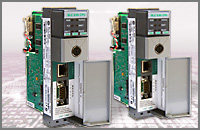 ABOVE: SLC 500 programmable logic controller from Allen-Bradley. |
AMAZON multi-meters discounts AMAZON oscilloscope discounts Programmable Logic Controllers (PLC) implement specific functions such as:
|
 ABOVE: SIMATIC Controller from Siemens |
Although programmable controllers have been available since the mid-1970s, developments-such as the ready availability of local area networks (LANs) in the industrial environment, standardized hardware interfaces for manufacturer interchangeability, and computer software to allow specification of the control process in both traditional (ladder logic) and more modern notations such as that of finite-state machines-have made them even more desirable for industrial process control. Programmable logic controllers are typically implemented by using commonly available microprocessors combined with standard and custom interface boards which provide level conversion, isolation, and signal conditioning and amplification. Microprocessors used in programmable controllers are similar or the same as those used in personal computers. The software of a programmable controller must respond to interrupts and be a real-time operating system, characteristics which the typical operating system of a personal computer does not possess. Perhaps the biggest benefit of programmable controllers is their small size, which allows computational power to be placed immediately adjacent to the machinery to be controlled, as well as their durability, which allows them to operate in harsh environments. This proximity of programmable controllers to the equipment that they control allows them to effect the sensing of the process and control of the machinery through a reduced number of wires, which reduces installation and maintenance costs. The proximity of programmable controllers to processes also improves the quality of the sensor data since it reduces line lengths, which can introduce noise and affect sensor calibration. |